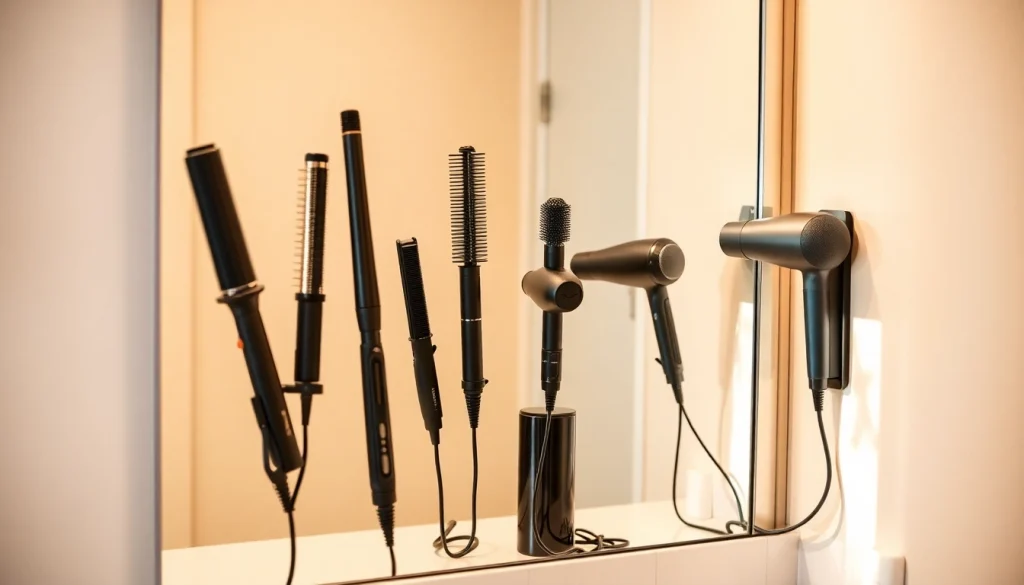
1. Understanding Heat Tools for Hair
What Are Heat Tools and How They Work
Heat tools for hair are specialized devices designed to manipulate the shape and texture of hair using controlled levels of heat. These tools primarily include hair dryers, flat irons, curling wands, and heated styling brushes, each functioning by applying heat directly to the hair strands. When heat is applied to hair, it causes the water molecules in the strands to evaporate, allowing the hair to be molded into desired shapes. This transformation is facilitated through a chemical change in the hair’s protein structure, particularly in the keratin that constitutes the hair fiber.
Benefits of Using Heat Tools for Hair Styling
The use of heat tools can significantly enhance styling versatility, making it possible to achieve a wide range of looks—from sleek straightness to voluminous curls. Aside from aesthetic benefits, heat tools can also assist in giving hair a polished finish, due to the smoothening effect heat has on the cuticle layer of the hair, leading to an overall shinier appearance. Moreover, when used effectively, heat tools can save time during the styling process, providing long-lasting results that can withstand the rigors of a busy day.
Common Types of Heat Tools for Different Hair Types
Choosing the right heat tool often depends on hair type and texture. Here are common types of heat tools suited for various hair types:
- Flat Irons: Ideal for straightening thick or coarse hair, they come in various plate sizes and can reach higher temperatures for effective styling.
- Curling Irons: Available in different barrel sizes, these are perfect for creating varying degrees of curls and waves, suitable for all hair types when used correctly.
- Hot Brushes: These are particularly beneficial for adding volume and smoothness to medium to fine hair, combining the functions of a brush and a styling tool.
- Hair Dryers: Essential for rapidly drying hair, they also help in styling, especially with volumizing attachments.
2. Choosing the Right Heat Tool for Your Hair
Factors to Consider When Selecting Heat Tools
When choosing heat tools for hair, several factors should be considered to ensure optimal styling results while minimizing damage:
- Hair Type: Thick and coarse hair can tolerate higher heat settings, while fine or damaged hair requires lower temperatures to prevent further damage.
- Tool Material: Materials such as tourmaline and ceramic are favored for their ability to distribute heat evenly and reduce hot spots, which can lead to breakage.
- Adjustable Heat Settings: Look for tools that offer multiple heat settings. This allows for greater control and customization according to hair texture and styling needs.
- Ease of Use: Ergonomics matter; tools that are lightweight and easy to manipulate can enhance the styling experience.
Understanding Temperature Settings for Various Hair Types
Temperature settings are crucial in ensuring the longevity and health of your hair. Here’s a quick guide:
- Fine Hair: 250°F to 300°F; lower temperatures help prevent damage.
- Medium Hair: 300°F to 350°F; a balance for effective styling.
- Thick Hair: 350°F to 400°F; higher settings are needed for optimal results.
Tips for Picking Professional-Quality Heat Tools
Investing in professional-quality heat tools often yields better results and durability. Here are some tips on how to make an informed choice:
- Research Brands: Reputable brands such as Bio Ionic and FHI Heat are known for their quality and innovation.
- Read Reviews: Customer feedback is invaluable. Look for feedback on performance, ease of use, and durability.
- Check for Guarantees: Many professional tools come with warranties or guarantees, indicating confidence in their quality.
3. Best Practices for Using Heat Tools Safely
Heat Protection: Why It Matters
Using heat protectants is a crucial step in minimizing heat damage. These products coat the hair and act as a barrier against high temperatures. Applying a sufficient amount of heat-protecting spray or serum before styling can drastically reduce the risk of dryness and breakage.
Signs of Heat Damage and How to Avoid It
Recognizing signs of heat damage can help prevent long-term harm. Look for:
- Dryness: Hair feeling brittle or lacking moisture.
- Split Ends: Split Ends indicate that the cuticle has been compromised.
- Lack of Elasticity: When hair becomes overly fragile and snaps easily.
Proper Techniques for Styling with Heat Tools
To minimize damage and achieve the best results, follow these styling techniques:
- Sectioning Hair: Always work in sections. This not only distributes heat more evenly but also helps in ensuring each strand is styled adequately.
- Do Not Go Over Same Sections Multiple Times: This can lead to severe damage, so aim to style in one pass when possible.
- Adjust Temperature Accordingly: Use the lowest effective temperature for your hair type to prevent unnecessary damage.
4. Comparing Top Brands of Heat Tools for Hair
Featured Reviews of Popular Heat Tool Brands
Several brands dominate the market for heat tools, each offering distinct features and advantages:
- Paul Mitchell: Known for professional-grade tools, their flat irons and curling wands are highly rated for even heat distribution.
- Hot Tools: Preferred by many stylists, they offer a wide range of heating tools that are reliable and affordable.
- Bio Ionic: Their unique technology focuses on nourishing hair while styling, ensuring reduced damage over time.
Price Ranges and Value for Money
Understanding price ranges is crucial for budgeting:
- Budget Tools: Typically range from $25 to $60 and can suffice for occasional users.
- Mid-Range Tools: Ranging from $60 to $150, these often provide better materials and technology.
- Professional Tools: Can cost $150 and up, often featuring advanced technology designed to protect hair while styling.
Customer Experiences and Recommendations
Many user experiences suggest that investing in a high-quality heat tool yields significant returns in styling effectiveness and hair health. Reading reviews on beauty platforms or forums can provide insights into what to expect from specific models and brands.
5. Maintenance and Care for Your Heat Tools
Cleaning and Storing Heat Tools Properly
To prolong the life of heat tools, regular maintenance is key. Clean the plates of flat irons and curling tools regularly to remove product buildup. Additionally, storing tools in a dedicated space, preferably in a heat-resistant pouch, can prevent accidental damages.
Extending the Life of Your Heat Tools
To extend the life of your heat tools:
- Unplug When Not in Use: This prevents overheating and potential hazards.
- Use Heat Protectant: Protect your tools from product residue that can cause malfunction over time.
- Regular Checks: Inspect cords and plugs for wear and tear.
Upgrades: When to Replace Your Heat Tools
Knowing when to upgrade your heat tools is crucial for maintaining hair health and styling efficiency. Signs it might be time to replace include an inability to reach temperatures, uneven heating, and damaged cords. Investing in new tools that incorporate improved technology can significantly benefit both the styling process and the health of your hair.
Overall, understanding heat tools for hair is integral to achieving desired hairstyles while maintaining healthy hair. Emphasizing safe usage, choosing quality products, and practicing regular maintenance will ensure effective styling results for years to come. For further exploration of heat tools for hair, consider various options available in the market.






